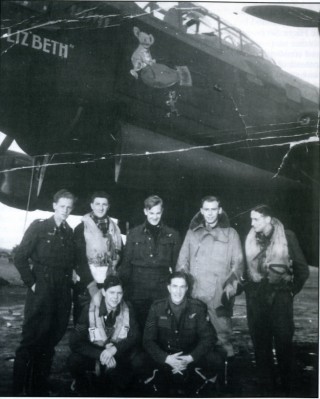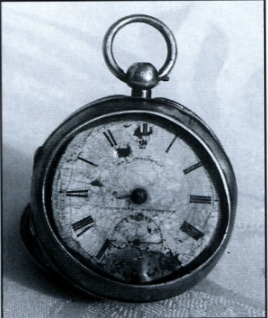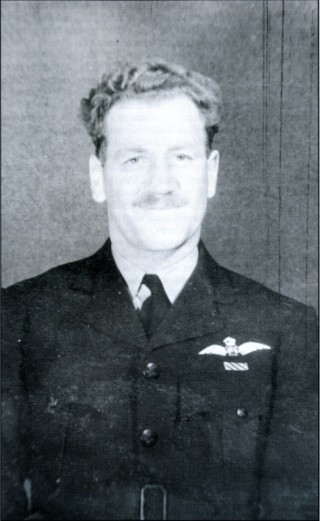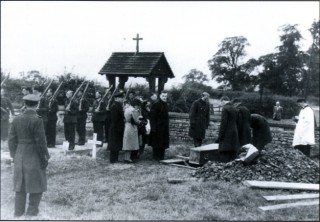Chapter 12: On the other side of the hill
On the Wings of the Morning
Vincent Holyoak
July saw a continuing interest in Italian targets, and on the afternoon of the 12th eighteen crews were briefed for an attack on Turin. The route required he bombers to fly south over France before turning South-East over Lake Annecy and, skirting south of the borders of neutral Switzerland, making their run-in to the target. The aircraft reached their turning-point just after midnight, but some time after the main stream had passed southwards, a single aircraft was heard circling in the rainy darkness over the Swiss town of Sion. Its engines were misfiring badly, and it appeared to be attempting to gain height. The aircraft was 467’s ‘T-Tommy’ piloted by 23-year-old Flying Officer Graham Mitchell RAAE. He and his crew were on only their sixth operation together, and in dire trouble. Unable to maintain height, they jettisoned their 4,000 lb ‘cookie’ and some incendiaries in one last effort to reduce weight. Shortly afterwards PO- T passed low over the hamlet of Thyon, some 6,900 feet above sea level. As it did so it struck high tension wires and smashed into the ground, bursting into flames. The force of the impact scattered wreckage over hundreds of yards, killing all on board. They were buried together two days later at Vevy on Lake Geneva along with a 207 Squadron crew from Langar lost in similar circumstances. The service was swamped by local people wanting to pay their respects. Also attending were the British Air Attache in Berne, Air Commodore Freddie West VC and the Aga Khan, holidaying nearby.
For those reaching Turin, opposition was negligible. At briefing they had been warned that the weather front forming over France on their outward journey would be sufficiently developed on their return to make a detour out over the Bay of Biscay advisable. It would be dawn by this time, so they were told to keep at nought feet and to formate with other Lancasters if possible to increase fire power in the event of attack by the frequent Ju88 patrols in the area. Flight Lieutenant Bob Gibbs, deputy ‘C’ Flight commander, and his crew, dodging between the rain squalls, were never seen again. Over England it was a bright summer’s morning as the weary survivors made their way back. It was just before 9 0′ clock, and Ernie Dring, son of the landlord of Long Bennington’s The Wheatsheaf was standing on a hay rick on the edge of the village, already working on the day’s harvesting. As the Lancasters circled overhead waiting their turn to land, he was looking up, shielding his eyes against the sun to catch a glimpse of the letter ‘W’ which would tell him that Pilot Officer John Good had returned. The Aussie and his crew were frequent visitors to his father’s pub, and after closing would often accompany the barmaid back to her cottage on Back Lane where they sat talking until the small hours. Ernie would sometimes tag along, but as he now looked upwards, something unusual caught his eye. One of the returning Lancasters had a hole in its fuselage so big that daylight shone through.
In Flying Control the tension was almost tangible. Most of the other aircraft had landed but still nothing had been heard of Mitchell, Gibbs, Good, or Flight Sergeant Chapman. Twenty-year-old ‘Sid’ Chapman from Melbourne was engaged to a WAAF MT driver on the station named Elizabeth, and constantly flouted the radio procedure by using the callsign ‘L-Lizbeth’ instead of the usual ‘L-London’ on his Lancaster, LM311 PO-L. Elizabeth now stood in the corner of the watch office waiting to collect the returning crews and deliver them to debriefing, but as the minutes ticked by, all present were only too aware of her thoughts. Then Chapman’s voice came over the R/T. He explained that a flak hit over the target had severed his elevator cables and that he had very little fuel left. Could he attempt a landing using just the trimmer? A hurried discussion made it clear that given the fuel situation there was little alternative but to come in now, and permission was granted. All eyes were on ‘Lizbeth’ as she joined the circuit and made a steady, shallow approach from the direction of Bennington. Chapman was conscious of the fact that any further stress on the airframe must be avoided, so he waited until the last possible moment to put down the undercarriage. But it was too much. As the locks engaged the tail section separated and fluttered away. In slow motion ‘L’ reared upwards and stalled, striking the ground nose first a few seconds later. There was a flash, followed a few seconds later by a low rumble and a dirty black pall of smoke, dust and debris. The station fire engine raced out onto the main road but could do nothing. Thirty tons of Lancaster had smeared itself across the field, cutting a swathe in the long grass. There were no survivors, and two days later Arthur Cackett was one of those detailed to escort five flag-draped coffins to Bottesford station where they were loaded on goods waggons, bound for their families in Scotland.
In 1991 a walk across the field in which LM311 crashed revealed an instrument face from the flight engineer’s panel, an access panel bearing traces of black paint, and exploded .303 ammunition. A more detailed examination the following year by the Yorkshire Air Museum recovered large quantities of molten aluminium, oil-covered engine components and the pitot tube. On contacting Margaret Butterworth, widow of flight engineer Jack Greenwood, it was revealed that she still had her husband’s pocket watch (right). Battered and burnt, it stopped at 8.40 that day in 1943 and has never worked since.
The attack on Turin which had claimed Mitchell, Gibbs and Chapman was the last ‘op’ of his tour for Johnny Good, and he finished in style. He had lost an engine on the way out, but he and his crew did not want to abort and so jettisoned everything possible to gain enough height to cross the Alps. They went on to bomb the target with such accuracy that they were awarded one of the coveted ‘aiming points’. Whilst crossing the Bay of Biscay on the return journey they formated with another Lancaster, obviously in trouble. Good contacted the pilot over the R/T and asked what the problem was. They were a new crew, slightly panicky and low on fuel, so he instructed them to feather an engine and stayed close to give encouragement and advice. As they neared the coast his wireless operator contacted Tangmere and asked permission for their protege to land. Good declined the invitation to ‘pancake’ himself, wanting instead to press on for Bottesford and the planned end of tour party. He landed some considerable time after the other crews, and was rewarded with an immediate DFC.
This raid had been extremely traumatic for the Squadron in terms of losses, but they were on the order of battle again on 16th July when five 467 crews joined thirteen others from 5 Group attacking transformer stations in Northern Italy. 467’s target was Cislago in the foothills of the Alps. Only the night before, 617 Squadron had failed in its attempt to knock out two similar targets due to thick ground mist in the Alpine valleys. For this second attempt the crews were told not to attack until a ‘master of ceremonies’ arrived to guide their bombing. Unfortunately he was delayed, which left them orbiting the target for over an hour, giving nightfighters ample opportunity to attack. Pilot Officer Carmichael’s aircraft was intercepted by a Ju88, killing his navigator, although they shook off their attacker. Flight Lieutenant Harry Locke in ‘O-Orange’ decided enough was enough and set course for Spezia docks, the secondary target, and after bombing headed for Blida in North Africa as ordered. Before long dawn had broken, and the African coast was looming ahead, but they were unsure of their precise position, unable to raise Blida over the radio and very low on fuel. Soon after crossing the coast an aerodrome came into sight, so Locke took what was by now the only option and came in for a landing. His bomb aimer, Frank Townsend wrote:
Unfortunately it was a fighter aerodrome with a 400 yards long runway, so we went through a vineyard, over a deep railway cutting (off with the undercart) and made a perfect pancake. There were no injuries and we were entertained by the French CO. After six days in North Africa we were brought home via Gibraltar, although Tommy Munro (rear gunnner) was left behind for a few more days with dysentery. The rest of us came back with Wing Commander Burnett and stayed in Gib overnight where the Wingco filled the Lanc with wine and crates of bananas. He said ‘Pray!’ as we started to take off. We had 22 bods on board by now, so you can imagine our feelings, as only a few weeks before General Sikorski had gone straight into the drink from the end of the same I’ll n way. We flew lip the Bay of Biscay in daylight, and for a while the Wingco put the auto-pilot all and came back to play cards! We arrived at Bardney late at night where a 3 ton lorry waited to cart off the Wingco’s spoils.
The end of July and the beginning of August saw four raids in quick succession on Hamburg, the largest port in Europe and Germany’s second largest city. Although the city had been attacked before on no less than 98 occasions, Sir Arthur Harris considered it was time for it to suffer the full weight of a Bomber Command ‘maximum effort’. As a new departure he was allowing his crews to use ‘Window’ for the first time. This was the codename for the thin strips of tin foil which, when dropped in bundles, would confuse the German radar with spurious signals. With losses running so high it was just the sort of advantage the crews could appreciate, so spirits were high on the night of the first raid, 25/26th July. Sure enough, all of the 467 crews returned safely. On the following night there was a brief return to Essen, the raid inflicting the greatest damage on the Krupps works to date. Although, thanks to ‘Window’, the German fighters were still reeling and losses on this target were lower than usual, Sergeant Colin Harrison and crew in ED803 PO-A suffered a direct hit from flak which knocked out both starboard engines. With no hydraulics the flaps, bomb doors and undercarriage hung useless. Everything removable was thrown out to maintain height, and Jock Robertson, the flight engineer set the engines to a dangerously high 2850 revs, +9 boost. Harrison crash landed at Coltishall where Sergeant Fred Parry, the bomb aimer, recalls that the fighter pilots, having counted 163 holes in the airframe, told him and the rest of the crew that they should be awarded ‘Gongs as big as frying pans’ for getting her back. As it was, Harrison received an immediate DFM.
The second raid on Hamburg on the night of 27/28th July did not go so well for 467. Flight Sergeant Buchanan and crew, on their first operation, were shot down into the sea with no survivors. Pilot Officer Jim Carrington’s crew were on their twelfth operation: two managed to bale out. This was the night of Hamburg’s infamous ‘Firestorm’, brought about by unusually low humidity, high temperatures and an error in Pathfinder marking which moved the aiming point two miles east of the intended target. As it was, bombing around the markers was particularly concentrated, with an estimated 550-600 bomb loads falling in an area of two square miles over a densely packed working class district of the city. By far the most chilling statistic was the 40,000 estimated to have died in the inferno. A further 1.2 million fled the city in the days following this particular raid, a stark testimony to the awesome destructiveness of the bomber.
For the fourth and final attack on 2/3rd August the weather conditions were far from ideal. A thunderstorm meant that the pathfinders were unable to mark, so crews either jettisoned their loads and aborted, or bombed as best they could. Pilot Officer Dave Symonds took his Lancaster down to 6,000 feet over the city, to see through the dense pall of soot and smoke and make an accurate bombing run. They were attacked by a fighter, but managed to evade it without damage, or so they thought. However, there was no answer from the rear gunner, Sergeant B.N. Pratt, and a check revealed that he had been killed by a single bullet to the head. ‘Mike’ Pratt was buried at St. Swithun’s in Long Bennington. David Symonds wrote:
Mike was a cocksparrow of a cockney. When we went for a drink in a crowded bar and I was jostled, Mike would take all the offender with all of his 5’4′, and I would have to rescue him from disaster. More importantly, we, the crew had to bury Mike in that grave. Full military honours, rifle shots, the lot. But when we arrived back at Bottesford the hard part started. As we disembarked from our truck the senior WAAF officer called out to me. There was Mike’s mother. A tiny figure in black, she walked towards me as I stood rigidly to attention. She took both my hands, and I waited for what? Curses? Instead, and I’ll always remember this, she said, ‘Mike said, “Don’t worry Mum, Skip will always bring me home”. Thank you for bringing him home to England’. She released my hands and walked back to the WAAF officers. That Hamburg trip was rough for all my crew, but for me, that little lady from the East End was the hardest.













No Comments
Add a comment about this page